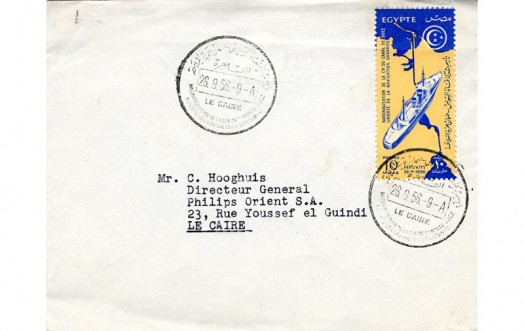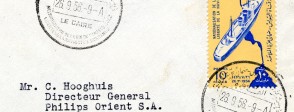The stamp
The nationalisation of the Suez Canal by Egypt on 26 July 1956 is commemorated on this stamp. Printed in two colours, the background shows a map of the Suez region bisected by the canal. The straight sections of the man-made canal, created in the 1860s to enable steamship passage between the Mediterranean and the Red Sea, are clearly visible.
The writing in French and Arabic says: ‘Egypt; Nationalisation of the Suez Canal Company; Freedom of navigation guaranteed’. Control over passage through the canal was of vital importance both strategically and financially. At the time of nationalisation, navigation was free for all except Israeli ships or those bound for Israel. The envelope is addressed to the Dutch Director General of Philips Orient, a joint-stock subsidiary of the Philips music company which sold music recordings across the Arab world. Cairo at the time was the centre of a thriving Middle Eastern music scene from which European companies sought to profit.
Suez as a focus of global interest
Suez is located at the north end of the Red Sea, the waterway which leads into the Indian Ocean. Around 90 miles north of Suez is Port Said on the Mediterranean, therefore this stretch of land is the shortest distance between these two great regions of maritime trade. Opened in 1869, the canal was financed jointly by the French and Egyptian governments and enabled steamships carrying people and commodities for trade to travel directly between Europe and Asia. Previously, goods had to be unloaded, transported by land and reloaded, or ships travelled all around Africa. In the age of high imperialism there was a huge amount of sea traffic, for example, Britain’s economic prosperity depended upon trade with her imperial territories, particularly India. The canal therefore became a point of strategic importance for many European nations.
Economic difficulties for Egypt in the 1870s led their government to sell their 44% of shares in the Canal Company to Britain for £4 million. Britain therefore was able to control the finances and operations of the canal. Many examples over the next forty years, including its defence during World War I, demonstrated the importance of the canal to Britain. The Anglo-Egyptian treaty in 1936 recognised Egypt as an independent sovereign state, but allowed British troops to be stationed in the region around the Canal.
Decolonisation and increasing tension in the Middle East
Several factors contributed to heightening tensions after World War II. Indian independence in 1947 symbolised the era of decolonisation as European colonies gained freedom from their colonial masters. The USA encouraged these moves towards independence, motivated at least partly by fears about the spread of communism in these new nations. Both the USA and the USSR were keen to shore up support within the new nationalist movements and supplied military and diplomatic support, thus drawing them into the orbit of the Cold War. The creation of Israel in 1948, following the atrocities suffered by Jews during World War II, was a further source of conflict in the Middle East, with the expulsion from their lands of hundreds of thousands of Palestinian people. In Egypt, the early 1950s saw nationalist movements gain momentum and in 1954 the nationalist party overthrew King Farouk and General Gamal Abdel Nasser became president.
Britain and other European nations were undergoing significant economic hardship after the war. No longer was access to imperial territories their priority in Suez. As the historian Yergin wrote, the new role of the canal was as ‘the highway not of empire, but of oil’; in 1955, petroleum made up half of all the canal’s traffic. Worsening relations between the British and the Egyptians over British occupation and control of the canal led to its nationalisation by General Nasser, prompting Britain, France and Israel to seize the canal by force in October 1956.
Diplomatic crisis and aftermath
International opinion greatly opposed the military action. Britain was already engaged in wars against insurgent nationalist movements in Malaya and Kenya and to many the invasion of Suez appeared as the last gasp of Empire in the face of the ebbing away of Britain’s power worldwide.
The USA supported the right to self-determination against imperial rule and wanted united international solutions to conflict in the Middle East rather than direct military action, which it worried might provoke further communist intervention. The Americans also feared that US involvement would elicit a response from the USSR that aligned the Middle East along Cold War alliances and risked the whole region’s descent into war. The USSR wished to keep the canal open and free for economic reasons and so supported a diplomatic resolution. They also wanted to support Nasser in order to weaken US dominance in the region. Coupled with opposition at home in Britain, this international pressure led to the withdrawal of British and French troops and UN forces were sent to restore order. The canal was reopened to shipping in April 1957.
The Suez Crisis was the first of many instances where Cold War opposition between the USA and the USSR determined the outcome of world events. Although British and US relations were strained by the crisis, the two countries went on to cooperate during the Cold War against the USSR, with the USA as the senior power. The whole episode starkly demonstrated where global power now lay. In the Middle Eastern context, control of the Suez region and the Sinai Peninsula continued to be a source of tension between Israel and Egypt, particularly in the Arab-Israeli wars of 1967 and 1973.
More information
BBC summary of the Suez crisis
http://www.bbc.co.uk/history/british/modern/suez_01.shtml
BBC 4 documentary: The Other Side of Suez
Extracts could be useful in the classroom.
https://www.youtube.com/watch?v=ETOUALw2EIs
Timeline of the crisis
http://www.bodley.ox.ac.uk/dept/scwmss/projects/suez/suez.html
Overview of the crisis (Guardian)
Note that not all links at the bottom are live.
http://www.theguardian.com/politics/2001/mar/14/past.education1
Overview of the crisis (Economist)
http://www.economist.com/node/7218678
Overview from the National Archives
http://www.nationalarchives.gov.uk/cabinetpapers/themes/egypt-suez.htm
1960 film about the crisis
http://www.nationalarchives.gov.uk/films/1951to1964/filmpage_suez.htm
More information
-
BBC summary of the Suez crisis
Source: bbc.co.uk
-
BBC 4 documentary: The Other Side of Suez
Extracts could be useful in the classroom.
Source: youtube.com
-
Timeline of the crisis
Source: ox.ac.uk
-
Overview of the crisis (Guardian)
Note that not all links at the bottom are live.
Source: theguardian.com
-
Overview of the crisis (Economist)
Source: economist.com
-
Overview from the National Archives
Source: nationalarchives.gov.uk
-
1960 film about the crisis
Source: nationalarchives.gov.uk



